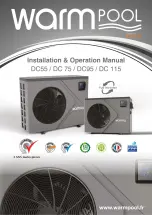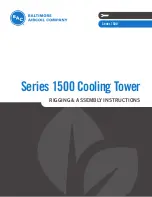
19
supply pressure tap is provided on the upstream side of the
gas valve. A manifold pressure tap is provided on the gas
valve. The normal manifold pressure for full input is 3.5" w.c.
on natural gas and 9.5" w.c. for propane gas. Low fire natu-
ral gas 2.0” w.c., 6.0” low fire propane gas. Minimum gas
supply pressure is 5.5" w.c. for natural gas and 11.0" for pro-
pane gas. In order to obtain rating, gas supply pressure must
be 11.0" w.c. for propane gas.
The pressure regulator on LP gas models is adjusted for 9.5"
w.c. manifold pressure and is intended to prevent over-firing
only. Do not attempt adjustment of the built-in pressure regu-
lator unless the supply pressure is at least 7.0" w.c. on natu-
ral gas or 13.0" w.c. on propane gas. Check the location of
the ignition electrode and the flame sensor for correct gap
setting.
Flame Sensor and Ignition Electrode Location
NATURAL
(Dia)
PROPANE (LP)
(Dia)
45,000
2
23,000
#43
#55
115,000
5
23,000
#43
#55
140,000
6
23,000
#43
#55
90,000
4
23,000
#43
#55
GAS ORIFICES
MAXIMUM
INPUT
(BTUH)
NUMBER
of
BURNERS
MAXIMUM
BTUH/BURNER
Heat Exchanger and Burner Orifice Specifications
NOTE:
Gas appliances located more than 2000 feet above
sea level must be derated 4% per 1000 feet of total elevation
and that variance in gas heating value and specific gravity
require change in manifold pressure to obtain rating, it is
mandatory that the input be adjusted at the installation site.
All installations should be made as outlined in the latest edition
of the National Fuel Gas Code ANSI Z223.1,section
“Procedures To Be Followed To Place An Appliance in
Operation”. Refer also to the “User’s Information Manual”
supplied with the unit for additional information on the gas
furnace.
Unit Shutdown
1. Set the thermostat to lowest setting.
2. Turn off the electrical power supply to the unit.
3. Remove the heat exchanger door on the side of the
unit by removing screws.
4. Move the gas control valve switch to the OFF position.
Do not force.
5. Close manual gas shutoff valve external to the unit.
6. Replace the heat exchanger door on the unit.
7. If cooling and/or air circulation will be desired, turn
ON the electrical power.
NORMAL SEQUENCE OF OPERATION
H
EATING
This unit has one (RS) Manual Reset Limit Control Switch.
Check the limit to make sure it has not tripped. The limit may
arrive at the job site tripped as a result of shipping shock.
If the ventermotor comes on, but the unit does not attempt
ignition, check if the ALS (Auxiliary High Limit Control Switch)
requires resetting.
1. With electricity and gas turned on, the system switch
in the “HEAT” or “AUTO” position and the fan switch
in the “AUTO” position, the thermostat will close the
circuit between unit terminals R and W (R-W) when
the temperature falls below the thermostat setting.
2. D1 on IIC energizes relay IDMR.
3. Relay IDMR energizes the ventermotor IDM.
4. Operation of the ventermotor closes the pressure
switch PS located in the burner compartment. Unless
excessive temperatures or shipping shock have
opened high limit control ALS, power is fed to the
integrated ignition control, which then initiates a 15-
second pre-purge time delay. During this period, the
ventermotor will clear the combustion chamber of any
residual gas.
5. After the pre-purge period, the ignition control
energizes the Wl-C gas valve and simultaneously
initiates a “three (3)-try” spark ignition sequence.
6. When the burners are ignited, a minimum one (1)
micro-amp DC current will flow through the flame
between the sensor electrode and the grounded
burner.
7. When the controller proves that the flame has been
established, it will keep the gas valve energized and
discontinue the ignition spark. High stage manifold
pressure will be approximately 3.5" w.c. for natural
gas and 10.0" w.c. for propane (LP). Low fire natural
gas is 2.0” w.c.; low fire propane 6.0” w.c.
8. If the control is unable to ignite the burners after its
initial attempt, it will initiate another purge and spark
sequence. A third purge and spark sequence will be
initiated if the second attempt is unsuccessful. If the
third attempt is unsuccessful, the controller will close
the gas valve and lock itself out. It may be reset by
momentarily interrupting power. This may be
accomplished by briefly lowering the room thermostat
set-point below room temperature, or by shutting off
the main power to the unit. (See TP-105 for more
details.)
Summary of Contents for CPG SERIES
Page 35: ...35 APPENDIX D WIRING DIAGRAMS...
















































